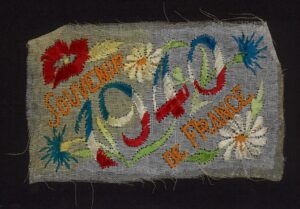Embroidered Silk Postcards
During World War One, a popular souvenir amongst British soldiers was the embroidered silk postcard. As they were quite an expensive souvenir, a lot of postcards were unwritten and unmarked and sent home with accompanying letters to loved ones.

Eden Camp Archive
First shown at the Paris Exposition in 1900, postcards were bought in France as sentimental greeting cards before 1914. Each blank postcard had an embossed paper surround framing a piece of silk. Some featured a silk pocket into which a pre-printed card could be found. Hand embroidered onto the silk were a vast number of designs, usually patriotic or sentimental. Flags, butterflies, birds and rainbows were common as they showed the bright colours of the threads extremely well. Some also had words embroidered in a single colour. The hand embroidery was usually carried out in domestic houses as ‘out-work’ by women and children in France and Belgium. They worked the embroidery in strips of silk organza up to 25 cards’ worth long. The finished strips were then sent to factories in cities such as Paris, where they would be cut and mounted ready to be sold.
Woven by machinery, factory made embroidered silk postcards were much more elaborate in design. They contained far more complex images, generally depicting the war destruction of historic buildings in towns such as Péronne and Arras or recognisable portraits such as Edith Cavell, General Haig and Lord Kitchener.

Eden Camp Archive
Amongst collectors, embroidered silk postcards featuring cap badges of individual regiments are some of the most sought after as they contained intricate designs often requiring great skill to reproduce in thread.
Embroidered silk postcards were proudly displayed for years on mantle shelves and bedside tables by the loved ones who received them. As a result, postcards are often sun-bleached and faded, or stained from exposure to coal dust and nicotine. As silk is sensitive to light, handling and humidity, some embroidered silk postcards may now show signs of tearing in the silk and there could also be small holes forming. Also, the card used to mount the embroidery was often poor quality and may now have brown staining, known as ‘foxing’, due to acids.
Popularity for embroidered silk postcards increased again at the beginning of World War Two, when members of the British Expeditionary Force (BEF) bought and sent home postcards to loved ones. These postcards had more subdued colours and a crimpled cut edge to the card.

